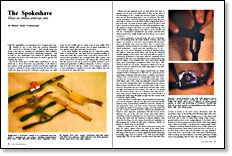
Synopsis: Michael S. Podmaniczky loves his spokeshaves. His description is almost photographic: the working face of a flat-soled spokeshave is machined flat, and apart from its extended handles, it looks and works like a plane with a very short, narrow sole. Viewed from the side, the sole is curved to a radius of about 1-1/2 in. He explains the different types available for purchase, how to select one, whether wood or metal, and how to tune it up. He offers advice on using spokeshaves for various difficult jobs and how to handle their quirks.
The spokeshave is a marvelous tool. Compact and comfortable to use, it can, with care, perform admirable service in a diversity of jobs. I find myself using one nearly every day for cleaning up drawknifed chair spindles, shaping and fairing curved parts, chamfering anything. . .and on and on. The spokeshave isn’t without its quirks, though, and unless you learn to live with them, it’s hard to get the tool working just right.
First of all, you’ve got to decide which spokeshave to use for which job or, if you don’t have any spokeshave at all, which to buy. A glance at the spokeshave section in my favorite wishbooks reveals an armload of choices priced between $4 and $24. You could buy them all, but the collection would leave too little room in your toolkit and too much room in your wallet. Most mail-order catalogs offer several sizes of metal spokeshaves in two generic types: flat-soled and curved-soled.
As its name implies, the working face of a flat-soled spokeshave is machined flat, and apart from its extended handles, it looks and works like a plane with a very short, narrow sole. A round-soled spokeshave has a straight blade, like a plane, and when viewed from the front its sole appears flat. Viewed from the side, however, the sole is curved to a radius of about 1 in. A half-round spokeshave is different altogether. It shows a concave sole from the front and has a blade curved along its width. A convex spokeshave is similar, but as the name implies, the sole is curved in the other direction.
Which you buy depends more on how much you want to squeeze out of your tool dollar than it does on the kind of woodworking you do. I whittle the selection down to manageable size by first deciding what I can do without. The halfround spokeshave, meant for shaping cylindrical parts like banister rails, is useless on work whose radius is larger than that of the tool’s sole. On work of lesser radius, you’ll do just as well with a smooth or block plane or a flat-soled spokeshave—after all, tangent is tangent and there’s no point cluttering up your toolbox with a single-purpose tool when a more versatile one will do. Combination spokeshaves are round and flat-soled shaves married by a single handle—good in theory, not so good in practice.
From Fine Woodworking #52
For the full article, download the PDF below:
Fine Woodworking Recommended Products

Veritas Micro-Adjust Wheel Marking Gauge

Suizan Japanese Pull Saw

Tite-Mark Marking Gauge






















Log in or create an account to post a comment.
Sign up Log in